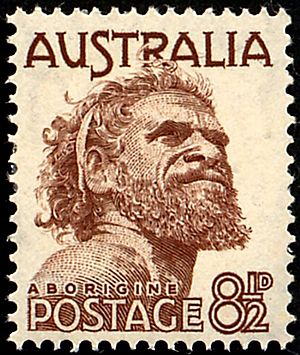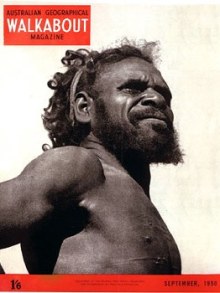Gwoya Tjungurrayi facts for kids
Gwoya Tjungurrayi (born around 1895 – died March 28, 1965) was a Walpiri and Anmatyerr man from the Northern Territory in Australia. He was also known as One Pound Jimmy. He became the first Aboriginal person to be shown on an Australian postage stamp. A special area for voting, called the Electoral division of Gwoja, was named after him.
Early Life and Nickname
Gwoya Tjungurrayi was born in the Tanami Desert of the Northern Territory, about 200 kilometers (124 miles) north-west of Alice Springs. This was near a place called Coniston Station, around the year 1895. His first name, Gwoja, means "water" or "rain" in the Anmatyerre language. His last name, Tjungurrayi, comes from his skin name.
In the early 1900s, more farms and cattle stations started to spread into Tjungurrayi's traditional lands. This caused problems, especially during a dry period in the 1920s, as people competed for water and food.
Tjungurrayi survived a terrible event called the Coniston massacre in 1928. Many Aboriginal people were killed during this time. Stories say that Tjungurrayi managed to escape and hide, even breaking free from chains. After this event, he lived in different places before settling at Napperby.
Tjungurrayi became known as 'One Pound Jimmy' because he made and sold boomerangs. When people asked how much his boomerangs cost, he would always say, "One pound, boss." In the 1930s, he and his family also caught dingoes and sold their skins.
A National Symbol
Gwoya Tjungurrayi became famous after a photographer named Roy Dunstan took a striking picture of him in 1935. A tourism executive, Charles H Holmes, had asked for the photo. Holmes described Tjungurrayi as a strong and impressive Aboriginal man.
This photograph was used on the cover of Walkabout magazine in 1936. People loved the picture so much that the magazine asked for Tjungurrayi to receive a gift of camping gear. Over the years, this photo and others were used in magazines and to promote tourism in Central Australia. Holmes said he used the images to show Jimmy as a "symbol of a vanishing race."
As he became known around the world, people would travel to Central Australia just to get Tjungurrayi's autograph or his fingerprint. Newspaper reports suggest that Tjungurrayi did not always like all this attention. He even shaved off his beard once to be less recognizable.
In 1950, his image was used on an 8½ pence stamp and a 2 shillings and 6 pence stamp. This made Tjungurrayi the first Aboriginal person to appear on an Australian postage stamp. The stamp was re-released in 1952 and sold over 99 million copies. He appeared on the cover of Walkabout magazine again in September 1950.
Later, in 1988, the design for the Australian two-dollar coin was inspired by a drawing of Tjungurrayi by artist Ainslie Roberts.
In 2019, a new voting area in the Northern Territory was created and named the Electoral division of Gwoja in his honor.
Family Life
Gwoya Tjungurrayi and his wife, Long Rose Nagnala, had three sons. Two of them, Tim Leura Tjapaltjarri and Clifford Possum Tjapaltjarri, became famous artists. Their third son, Immanuel Rutjinama Tjapaltjarri, became a Lutheran pastor. One of Tim Leura Tjapaltjarri's artworks, Ancestor Dreaming, was also featured on an Australian stamp in 1988.
Gwoya Tjungurrayi continued to live in the Tanami region until he passed away on March 28, 1965. He was thought to be over 70 years old when he died. His death was reported in the Northern Territory News and on the front page of the Centralian Advocate, which was a rare honor for an Aboriginal person at that time.



